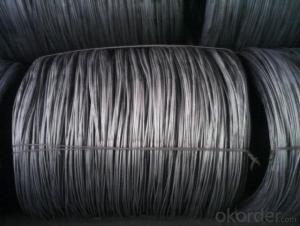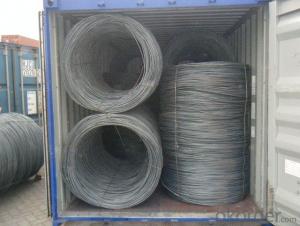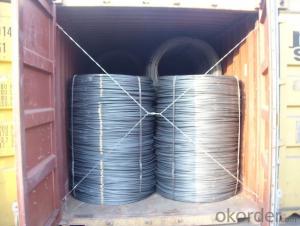Steel Wire Rod Low Carbon and Competitive Prices
- Loading Port:
- Tianjin
- Payment Terms:
- TT or LC
- Min Order Qty:
- 20 m.t.
- Supply Capability:
- 200000 m.t./month
OKorder Service Pledge
OKorder Financial Service
You Might Also Like
Product Description:
OKorder is offering Steel Wire Rod Low Carbon and Competitive Prices at great prices with worldwide shipping. Our supplier is a world-class manufacturer of steel, with our products utilized the world over. OKorder annually supplies products to European, North American and Asian markets. We provide quotations within 24 hours of receiving an inquiry and guarantee competitive prices.
Product Applications:
Steel Wire Rod Low Carbon and Competitive Prices are ideal for structural applications and are widely used in the construction of buildings and bridges, and the manufacturing, petrochemical, and transportation industries.
Product Advantages:
OKorder's Steel Wire Rod Low Carbon and Competitive Prices are durable, strong, and resist corrosion.
Main Product Features:
· Premium quality
· Prompt delivery & seaworthy packing (30 days after receiving deposit)
· Corrosion resistance
· Can be recycled and reused
· Mill test certification
· Professional Service
· Competitive pricing
Packaging & Delivery:
Packaging Detail: products are packed in bundle and then shipped by container or bulk vessel, deformed bar is usually naked strapping delivery, when storing, please pay attention to moisture proof. The performance of rust will produce adverse effect.
Each bundle weight: 2-3MT, or as required
Payment term: TT or L/C
Delivery Detail: within 45 days after received advanced payment or LC.
Label: to be specified by customer, generally, each bundle has 1-2 labels
Trade terms: FOB, CFR, CIF
FAQ:
Q1: Why buy Materials & Equipment from OKorder.com?
A1: All products offered byOKorder.com are carefully selected from China's most reliable manufacturing enterprises. Through its ISO certifications, OKorder.com adheres to the highest standards and a commitment to supply chain safety and customer satisfaction.
Q2: How do we guarantee the quality of our products?
A2: We have established an advanced quality management system which conducts strict quality tests at every step, from raw materials to the final product. At the same time, we provide extensive follow-up service assurances as required.
Q3: How soon can we receive the product after purchase?
A3: Within three days of placing an order, we will begin production. The specific shipping date is dependent upon international and government factors, but is typically 7 to 10 workdays.
Images:
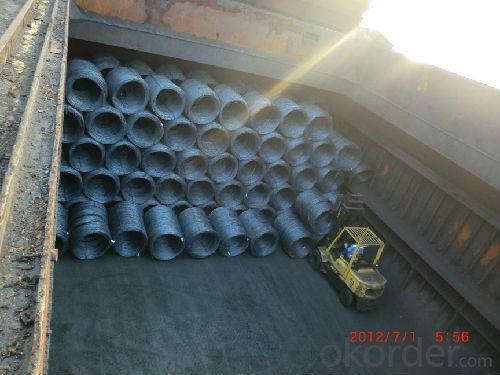
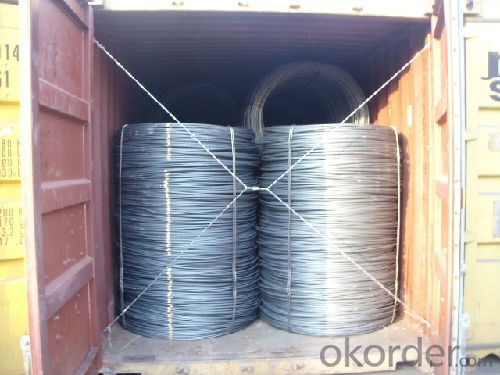
- Q:How is steel wire rod recycled at the end of its lifecycle?
- Steel wire rod can undergo steel scrap recycling at the end of its lifecycle. This involves a number of steps to transform the wire rod into reusable steel materials. To begin the recycling process, steel wire rod scraps are collected from various sources such as manufacturing waste, construction materials, or end-of-life products like old cars or appliances. Once collected, the scraps are sorted and separated based on their composition and quality. The sorted steel wire rod scraps are then sent to a recycling facility where they are shredded into smaller pieces to facilitate further processing. Shredding can be done using different methods, such as hydraulic shears or industrial shredders. After shredding, the steel wire rod pieces undergo magnetic separation to remove any non-ferrous materials like plastic or rubber that may be mixed with the scraps. Magnetic separators attract and remove these non-ferrous materials, leaving behind the steel wire rod pieces. The separated steel wire rod pieces are further processed to remove impurities or contaminants. This is done through a process called melting, where the wire rod pieces are heated to extremely high temperatures in a furnace. This melting process burns off or skims off any impurities or contaminants from the molten metal. Once the impurities are removed, the molten steel is poured into molds to form new steel products. The molds can vary depending on the desired shape and size of the final product. After the steel has solidified, it can be further processed and treated to meet specific requirements, such as tempering or strengthening. The recycled steel wire rod can be used as raw material in industries like construction, automotive manufacturing, and appliance production. This reduces the need for extracting and refining virgin iron ore, which conserves natural resources and minimizes environmental impact. In conclusion, steel wire rod is recycled through a series of steps including collection, sorting, shredding, magnetic separation, melting, molding, and further processing. This process allows the steel to be reused in various industries, promoting sustainability and reducing the demand for new steel production.
- Q:How is steel wire rod used in the production of wire for automotive seat springs?
- The production of wire for automotive seat springs relies heavily on steel wire rod, which is an indispensable component. To enhance its mechanical properties, such as strength, durability, and flexibility, the wire rod undergoes a series of steps involving heating and cooling. Once the steel wire rod has been processed, it is drawn down further to achieve the desired diameter for the seat springs. This drawing process entails pulling the wire rod through a set of dies, simultaneously reducing its diameter and increasing its length. This step is critical to attaining the desired mechanical properties and ensuring that the wire can withstand the stress and pressure experienced by automotive seat springs. Once the wire has reached the desired diameter, it is then shaped into the specific coil form required for the seat springs. Through the use of specialized machinery, the wire is coiled and molded into the desired shape, ensuring that it meets the design requirements and provides the necessary support and comfort for automotive seats. The use of steel wire rod in wire production for automotive seat springs is crucial due to its exceptional tensile strength and resistance to fatigue and corrosion. These properties enable the wire to withstand the constant pressure and movement experienced by automotive seat springs, resulting in long-lasting performance and durability. Additionally, steel wire rod offers the advantages of being cost-effective and readily available, making it the preferred choice for automotive manufacturers. Its versatility allows for customization, enabling the production of wire with specific characteristics tailored to meet the requirements of different types of seat springs. In conclusion, steel wire rod plays a vital role in the production of wire for automotive seat springs. Through various processing steps, the wire rod is transformed into high-quality wire that possesses the necessary strength, durability, and flexibility to support and provide comfort to automotive seats.
- Q:What are the advantages of using steel wire rod in oil and gas applications?
- There are several advantages to using steel wire rod in oil and gas applications. Firstly, steel wire rod offers high strength and durability, making it suitable for demanding environments and ensuring reliable performance. Additionally, steel wire rod has excellent corrosion resistance, which is crucial when exposed to harsh conditions and corrosive substances in the oil and gas industry. Furthermore, steel wire rod can be easily fabricated and customized to meet specific requirements, allowing for flexibility in design and application. Lastly, steel wire rod is readily available and cost-effective, making it a practical choice for oil and gas applications.
- Q:How is steel wire rod used in the production of wire fencing?
- Steel wire rod is used as the primary material in the production of wire fencing. It is typically drawn through various dies to reduce its diameter and increase its strength, resulting in the creation of wire strands. These strands are then twisted or woven together to form the structure of the wire fencing. The steel wire rod provides durability, strength, and rigidity to the fencing, ensuring it can effectively contain livestock, secure property boundaries, or serve other protective purposes.
- Q:How is the weldability of steel wire rod evaluated?
- The weldability of steel wire rod is typically evaluated through various tests and assessments such as bend tests, tensile tests, and Charpy impact tests. These tests help determine the weldability characteristics of the steel wire rod, including its ability to withstand welding processes without developing defects or cracks. Additionally, the chemical composition, microstructure, and mechanical properties of the steel wire rod are also considered in evaluating its weldability.
- Q:What are the common applications of stainless steel wire rod?
- Some common applications of stainless steel wire rod include wire mesh for filters and screens, electrical conductors, reinforcement in concrete structures, wire rope for lifting and rigging, and various mechanical components in industries such as automotive, aerospace, and construction.
- Q:How does steel wire rod compare to other materials in terms of strength and durability?
- Steel wire rod is widely regarded as one of the strongest and most durable materials available in the market. When compared to other materials, such as aluminum or copper, steel wire rod boasts superior strength and durability. Firstly, steel wire rod has an exceptional tensile strength, meaning it can withstand significant pulling forces without breaking or deforming. This strength is crucial in applications where the material is subjected to heavy loads or high-stress conditions. In comparison, aluminum or copper wire rod would typically have lower tensile strength, making them more susceptible to deformation or breakage under similar circumstances. Additionally, steel wire rod exhibits remarkable durability due to its resistance to corrosion, wear, and fatigue. Steel has a natural ability to withstand adverse environmental conditions, making it suitable for various harsh environments, including outdoor or marine applications. On the other hand, materials like aluminum or copper are more prone to corrosion and wear, which can compromise their strength and longevity over time. Moreover, steel wire rod offers excellent structural integrity, allowing it to maintain its strength and shape even when exposed to extreme temperatures or heavy mechanical stress. This characteristic makes steel wire rod highly suitable for demanding applications where safety and reliability are paramount, such as construction, automotive, or aerospace industries. Comparatively, materials like aluminum or copper may experience greater deformation or loss of strength under similar conditions. In conclusion, steel wire rod surpasses other materials in terms of strength and durability. Its exceptional tensile strength, resistance to corrosion and wear, as well as its ability to withstand extreme conditions, make it the preferred choice in numerous industries. Whether it is used for structural purposes, reinforcement, or support, steel wire rod consistently delivers superior performance, ensuring reliability and longevity in various applications.
- Q:What are the main factors affecting the formability of steel wire rod?
- The main factors affecting the formability of steel wire rod include the composition and quality of the steel, the temperature at which the forming process takes place, the speed and force applied during forming, and the presence of any impurities or defects in the material. Additionally, the diameter and shape of the wire rod, as well as the lubrication used during forming, can also influence its formability.
- Q:What are the common surface treatment methods for steel wire rod?
- The common surface treatment methods for steel wire rod include hot-dip galvanizing, electro-galvanizing, phosphating, and coating with a protective layer such as zinc or polymer.
- Q:How is steel wire rod used in the manufacturing of wire brushes?
- Steel wire rod is used as the main material in the manufacturing of wire brushes. It is typically cut into desired lengths and then twisted or coiled to create the bristle part of the brush. The steel wire rod provides durability, strength, and flexibility to the brush, allowing it to effectively clean and scrub various surfaces.
1. Manufacturer Overview |
|
|---|---|
| Location | |
| Year Established | |
| Annual Output Value | |
| Main Markets | |
| Company Certifications | |
2. Manufacturer Certificates |
|
|---|---|
| a) Certification Name | |
| Range | |
| Reference | |
| Validity Period | |
3. Manufacturer Capability |
|
|---|---|
| a)Trade Capacity | |
| Nearest Port | |
| Export Percentage | |
| No.of Employees in Trade Department | |
| Language Spoken: | |
| b)Factory Information | |
| Factory Size: | |
| No. of Production Lines | |
| Contract Manufacturing | |
| Product Price Range | |
Send your message to us
Steel Wire Rod Low Carbon and Competitive Prices
- Loading Port:
- Tianjin
- Payment Terms:
- TT or LC
- Min Order Qty:
- 20 m.t.
- Supply Capability:
- 200000 m.t./month
OKorder Service Pledge
OKorder Financial Service
Similar products
New products
Hot products
Hot Searches
Related keywords
